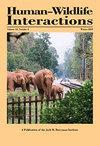Household Perceptions and Patterns of Crop Loss by Wild Pigs in North India
IF 0.9
4区 环境科学与生态学
Q4 BIODIVERSITY CONSERVATION
引用次数: 3
Abstract
Loss to cultivated crops by wild pigs (Sus scrofa) is widespread and can jeopardize low-income farmers. In India, although there is lot of political interest in the problem, efforts to understand the patterns, correlates, and underlying reasons for wild pig conflict continue to be minimal. We quantified loss of wheat (Triticum aestivum) to wild pigs and assessed the spatial patterns of damage in a forest settlement of Van Gujjar (Haridwar, India), which is a dairy-based pastoralist community. We chose a 4-km2 cultivated area comprising 400 farmlands (each measuring 0.8 ha and belonging to a family) and assessed crop damage by wild pigs through field surveys during the harvest season. We interviewed 159 respondents who manage 219 of the total 400 farmlands in the study area to compare actual crop loss with perceived losses. Wild pigs damaged 2.29 tonnes (2,290 kg) of wheat, which was about 2.6% of the potential yield in the study area. A total of 39 farmlands (9.5%), managed by 28 respondents, suffered losses during the survey period at an average loss of about 58.8 kg (SD ± 89.5, range = 0.7–388 kg). During interviews, 81 respondents managing 155 farmlands (70.7%) reported having suffered wild pig-related crop loss during the survey period. They also perceived losing about 23.4% of the potential yield of wheat due to wild pigs. The perceived losses were much higher than actual losses. Actual losses measured through field surveys underscore the dichotomy between actual and perceived crop loss due to wild pigs. About 81% of recorded wild pig-related damage to wheat occurred within 200 m from the forest edge. The crop protection measures aimed at stopping wild pigs from entering the fields were mostly reactive. Although overall crop losses due to wild pigs seem low at the settlement level, for affected individual families, the losses were financially significant. Such recurrent crop losses can cause families to go into debt, trigger animosity toward conservation, and lead to retaliation measures, which may be indiscriminate and have the potential to affect other endangered mammals in conservation priority landscapes. Because crop losses by wild pigs are severe along the narrow band of fields along the edge of the forest, channeling monetary benefits through insurance-based compensation schemes can help assuage losses to farmers. Further, because crop damage by wild pigs is seasonal, experimenting with mobile fences that can be dismantled and packed away after use would be beneficial.北印度家庭对野猪造成的作物损失的看法和模式
野猪(Sus scrofa)对栽培作物造成的损失很普遍,可能危及低收入农民。在印度,尽管对这个问题有很多的政治兴趣,但了解野猪冲突的模式、相关性和潜在原因的努力仍然很少。我们量化了野猪对小麦(Triticum aestivum)的损失,并评估了Van Gujjar (Haridwar,印度)一个以乳制品为基础的游牧社区的森林聚落的损害空间格局。我们选择了一个4平方公里的耕地,包括400个农田(每个农田面积为0.8公顷,属于一个家庭),并在收获季节通过实地调查评估了野猪对作物的损害。我们采访了159名受访者,他们管理着研究地区400个农田中的219个,以比较实际作物损失和感知损失。野猪破坏了2.29吨(2290公斤)小麦,约占研究地区潜在产量的2.6%。调查期间,共有39个农田(9.5%)遭受损失,由28个应答者管理,平均损失约58.8 kg (SD±89.5,范围= 0.7-388 kg)。在访谈中,管理155个农田的81个应答者(70.7%)报告在调查期间遭受了与野猪有关的作物损失。他们还认为,由于野猪的存在,小麦潜在产量损失了23.4%。感知损失远高于实际损失。通过实地调查测量的实际损失强调了野猪造成的实际和感知作物损失之间的对立。有记录的与野猪有关的小麦损害中,约81%发生在距森林边缘200米范围内。旨在阻止野猪进入农田的作物保护措施大多是被动的。虽然野猪造成的总体作物损失在定居水平上似乎很低,但对受影响的个别家庭来说,损失在经济上是巨大的。这种经常性的作物损失可能导致家庭负债,引发对保护的敌意,并导致报复措施,这些措施可能是不分青红皂白的,并有可能影响到优先保护景观中的其他濒危哺乳动物。由于野猪对森林边缘狭窄地带的作物造成严重损失,因此通过基于保险的补偿计划来引导货币利益可以帮助减轻农民的损失。此外,由于野猪对农作物的破坏是季节性的,试验使用后可以拆除和打包的移动围栏将是有益的。
本文章由计算机程序翻译,如有差异,请以英文原文为准。
求助全文
约1分钟内获得全文
求助全文
来源期刊

Human–Wildlife Interactions
Environmental Science-Nature and Landscape Conservation
CiteScore
2.80
自引率
0.00%
发文量
0
审稿时长
11 weeks
期刊介绍:
Human–Wildlife Interactions (HWI) serves the professional needs of the wildlife biologist and manager in the arena of human–wildlife conflicts/interactions, wildlife damage management, and contemporary wildlife management. The intent of HWI is to publish original contributions on all aspects of contemporary wildlife management and human–wildlife interactions with an emphasis on scientific research and management case studies that identify and report innovative conservation strategies, technologies, tools, and partnerships that can enhance human–wildlife interactions by mitigating human–wildlife conflicts through direct and indirect management of wildlife and increased stakeholder engagement. Our intent is to promote a dialogue among wildlife professionals concerning contemporary management issues. As such, we hope to provide a repository for wildlife management science and case studies that document and share manager experiences and lessons learned.
 求助内容:
求助内容: 应助结果提醒方式:
应助结果提醒方式:


